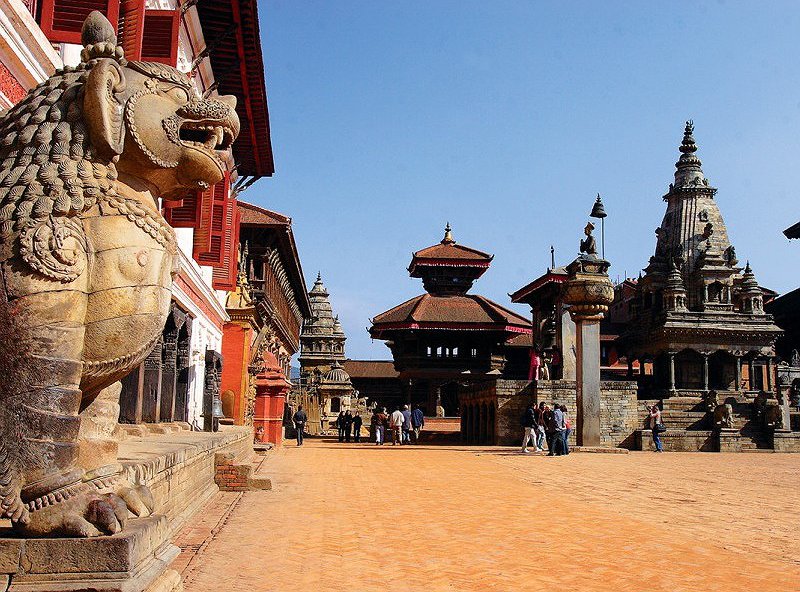This short Nepal tour program focuses on the magical culture and history of Kathmandu Valley. Inscribed in 1979 as a world heritage site, Kathmandu Valley consists of seven impressive monuments: Kathmandu Durbar Square, Bhaktapur Durbar Square, Patan Durbar Square, Changu Narayan, Boudnhanath, Swoyambunath and Pashupatinath. Soon after you head off to Nagarkot, one of the most popular hill stations, in the outskirts of Kathmandu Valley. Nagarkot offers panoramic views of Himalayas including beautiful sunset and sunrise. From Nagarkot, take an easy and short hike to Changu Narayan Temple to discover a collection of oldest scripture and medieval artifacts.
Itinerary
Day 1
Arrival at Tribhuvan International Airport, Kathmandu. Meet our airport representative and transport to hotel. Stay overnight at hotel.
Arrival at Tribhuvan International Airport, Kathmandu. Meet our airport representative and transport to hotel. Stay overnight at hotel.
Day 2
City tour of Kathmandu Durbar Square, Swoyambhunath, Boudhanath and Pashupatinath. Stay overnight at hotel.
City tour of Kathmandu Durbar Square, Swoyambhunath, Boudhanath and Pashupatinath. Stay overnight at hotel.
Boudhanath Stupa, situated 8 kilometers east of Kathmandu city, is one of the biggest Buddhist stupas in the world. The white washed dome is built with clay and brick which rests on an octagonal base which is festooned with prayer wheels in all direction. The shrine is encircled by houses of Lamas or Buddhist priest. The stupa is believed to have been in existence for over two centuries.
Situated 5 kilometers east from the center of Kathmandu City, Pashupatinath temple is one of the holiest Hindu temples dedicated to Lord Shiva. Situated amidst a lush green natural setting on the bank of the sacred Bagmati River, the temple built in pagoda style has jilted roof and richly-carved silver doors. Visitors are permitted to view the temple from the east bank of Bagmati River, as entrance into the temple is strictly forbidden to all non-Hindus! Pashupatinath is the centre of annual pilgrimage on the day of Shivaratri which falls in the month of February.
Swayambhunath Stupa, the holiest Buddhist shrine in Nepal, is located approximately 4 kilometers. The Stupa is estimated about 2000 years old and is formed of a solid hemisphere of brick and earth supporting a lofty conical spire capped by a pinnacle of copper gilt. Painted on the four sided base of the spire are the all-seeing eyes of Lord Buddha. This hill is a mosaic of small Chaityas and Pagoda temples.
Day 3
City tour of Patan and Bhaktapur and later drive to Nagarkot (2175m) for the Sunrise and Himalayan views. Stay overnight at hotel.
City tour of Patan and Bhaktapur and later drive to Nagarkot (2175m) for the Sunrise and Himalayan views. Stay overnight at hotel.
Bhaktapur, which means the city of devotees, still retains its ancient and medieval charm. Visitors to this ancient town are treated with myriad wonders of cultural and artistic achievements. Bhaktapur Durbar Square is famous for woodcarving, as is visible in the palaces, courtyards, and the traditional topi or cap. Pottery square is famous for making clay pots. The places of interest include Bhaktapur Durbar Square, the National Art Gallery, Bhairavnath Temple and Dattatreya Square.
The main square of the city contains innumerable temples and other architectural wonders such as lion gate, 55-window palace, the golden gate, the statue of King Bhupatindra Malla, Dattatraya Temple etc. The five storied Pagoda Style Nyatapola temple, built by King Bhupatindra Malla in 1708 A.D., is well known for its massive structure and subtle workmanship. It is the tallest pagoda structure in the Kathmandu.
Patan Durbar Square, like its counterpart in Kathmandu, is an enchanting mélange of palace buildings, artistic courtyards and graceful pagoda temples. Listed as a World Heritage Site, the former royal palace complex is the center of Patan’s religious and social life, and houses a museum containing an array of bronze statues and religious objects. One remarkable monument here is a 17th-century temple dedicated to the Hindu god Krishna, built entirely of stone. Other significant sites in Patan include Golden Temple, Kumbheshwar, Krishna Mandir, Jagat Narayan, Mahaboudha, Ashokan Stupa and Machchhendranath Temple.
Day 4
Enjoy early morning sunrise and mountain views from Nagarkot and drive from Nagarkot to Changu Narayan Temple and back to Kathmandu. Stay overnight at hotel.
Enjoy early morning sunrise and mountain views from Nagarkot and drive from Nagarkot to Changu Narayan Temple and back to Kathmandu. Stay overnight at hotel.
Changu Narayan is one of the oldest Hindu temples in Kathmandu Valley dedicated to Lord Vishnu. A world heritage site, the temple is home to the oldest stone inscription in Nepal. The temple rests on a small hillock called Changu and romantically surrounded by champak tree forests. The temple dates as far back as 5th century and has been built in pagoda style. The two-storey roofed temple stands on a high plinth of stone with rich embossed works and artistic struts. Visitors can also see the two museums in the premises that houses rich collection of arts and artifacts dedicated to the ethnography and history of the place.
Nagarkot is one of the most popular hill stations in Nepal. It is located abot 30 km from Kathmandu city and is at an altitude of 2000m. Tourists visit to Nagarkot to experience magnificent sunset and sunrise. It is also the nearest place to catch splendid views of Himalayan panorama, including Everest, Annapurna, Manaslu, Ganesh himal, Langtang, Jugal, Rolwaling, and Numbur. The hill also offers splendid views of the Kathmandu valley and Shivapuri national park along with quiet rolling hills, deep valleys, lush pine forests.
Day 5
Departure. As per your flight schedule, our airport representative will transfer from your hotel to the airport for your final departure.
Departure. As per your flight schedule, our airport representative will transfer from your hotel to the airport for your final departure.
 Make an inquiry
Make an inquiry